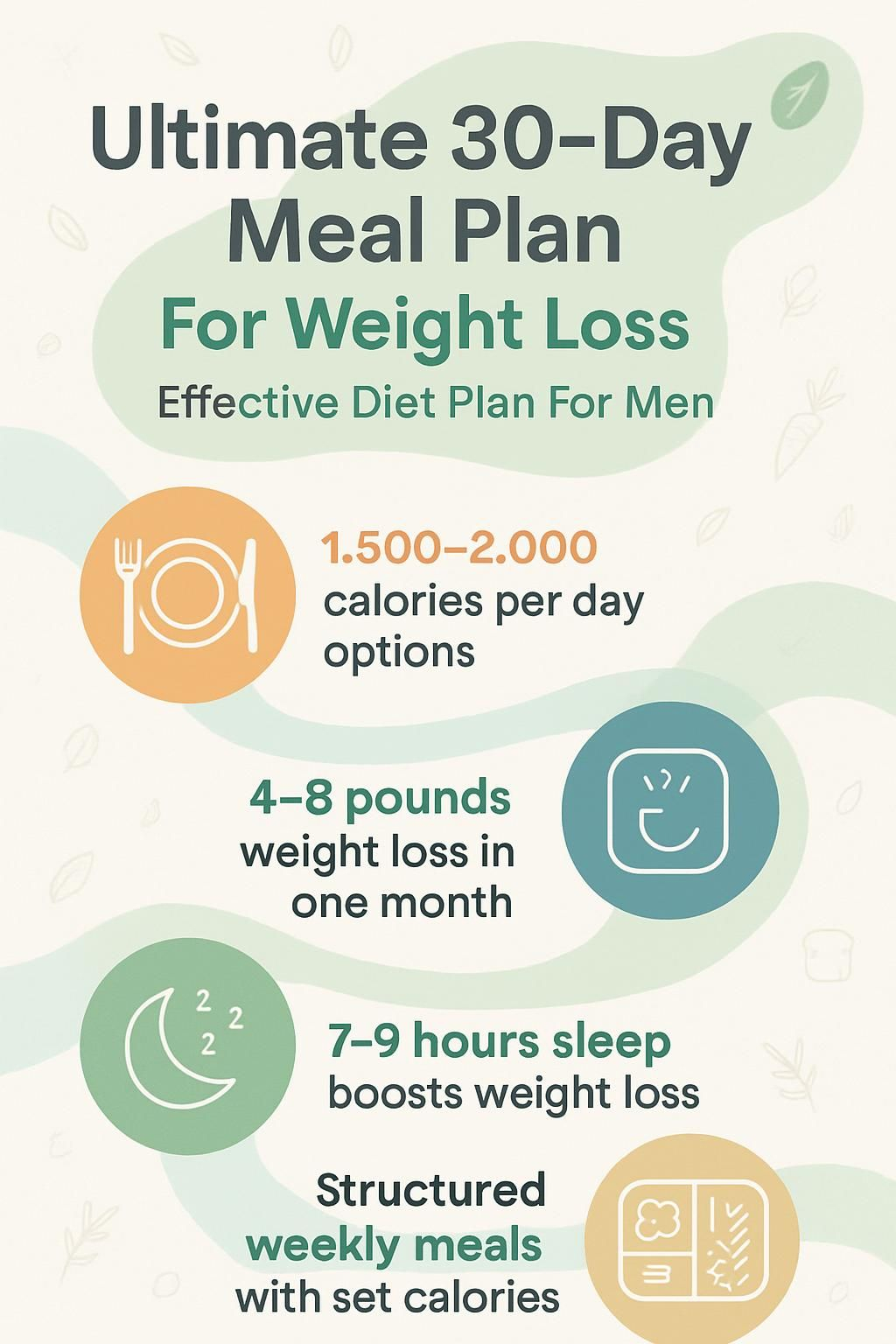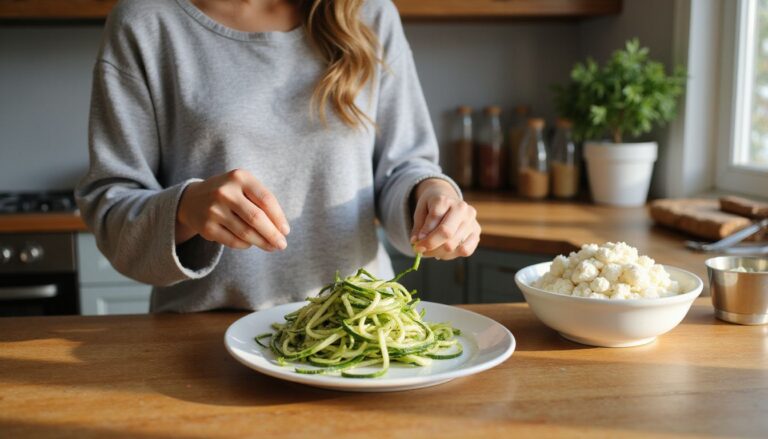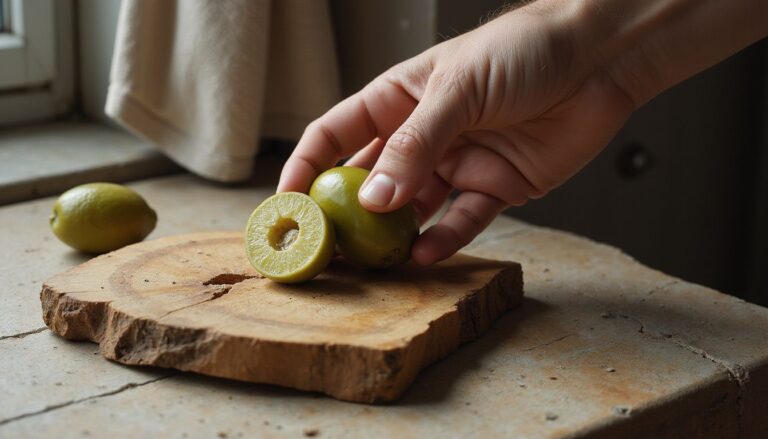Ultimate 30-Day Meal Plan For Weight Loss: Effective Diet Plan For Men
Our Nutrition Assistant AI Suite will transform your body. You will lose fat, get toned, and build muscle. Gain confidence and optimal health.
Starting a new diet can feel confusing. A simple, structured 30-day meal plan removes the guesswork and helps you act. Research shows planned meals support weight loss better than random choices.
This guide lays out an easy 30-day meal plan for men with daily menus at about 1,500 or 2,000 calories. You will see how to build high-protein, high-fiber meals with seasonal produce and whole grains. The focus is steady progress, clear habits, and real results.
Keep reading to find a plan you can follow with confidence.
Key Takeaways
- The 30-day meal plan includes daily menus at 1,500 and 2,000 calories to support safe weight loss, about 4 to 8 pounds in one month.
- High-protein meals, such as grilled chicken or Greek yogurt, help protect muscle and reduce hunger during a calorie deficit.
- Evidence cited includes CDC sleep guidance of 7 to 9 hours nightly and research in Obesity showing pre-meal water supports greater weight loss over 12 weeks.
- Each week provides structured breakfasts, lunches, dinners, and snacks with clear calorie targets so you can portion, log, and track progress.
- USDA Dietary Guidelines for Americans, 2020 to 2025, support lean proteins, whole grains, fruits, vegetables, healthy fats, hydration, activity, and batch cooking for lasting results.

Setting Realistic Weight Loss Goals

Clear goals prevent burnout and help you build habits that stick. Track small wins and use them to guide your next step.
What are achievable weight loss targets?
A safe rate is 1 to 2 pounds per week. Over 30 days, that equals about 4 to 8 pounds. For many men, a plan at around 2,000 calories supports steady fat loss while protecting muscle, especially with regular strength training.
Starting weight, age, activity, sleep, stress, and hormone balance all affect results. A high-protein approach with foods like chicken, fish, eggs, and Greek yogurt helps control hunger on fewer calories. Last year I meal prepped lean proteins with whole grains and saw real progress without feeling deprived.
Set targets you can keep. Small, steady changes build the base for long-term success.
Safe weight loss goals help you protect your health while making lasting changes.
How can I effectively track my progress?
Consistency beats perfection. Weigh at the same time each week and log it. Use a tape measure for waist, chest, and hips once weekly to capture body changes that a scale can miss.
Log meals and snacks in a journal or app. This 30-day meal plan shows daily calories and macronutrients, so you can check your numbers against your targets. Record workouts and water intake too. A walk, a lift session, or even one extra glass of water still counts.
The recipes use data from the ESHA Food Processor nutrition database to reduce guesswork. Many men discover that consistent numbers, especially for lunch and dinner, keep motivation high. If you want help adjusting your plan, share your log with a registered dietitian.
Key Factors for Successful Weight Loss
Good results come from a few core pillars. Nutrition, hydration, sleep, and activity work together like gears in a simple machine.
What are the nutritional needs and how to manage calories?
Your body needs balance while you cut calories. Aim for at least 67 grams of protein and 30 grams of dietary fiber per day. Fiber helps you feel full. Protein supports muscle and helps control hunger hormones like leptin and ghrelin.
Many men do well at about 1,500 calories. Very low calorie plans, near 1,200 calories, should only be used short term under medical guidance. Too few calories increase the risk of muscle loss and low energy.
Use smart swaps and ingredient reuse. Overnight oats with berries and strained yogurt can land under 350 calories. Need a 2,000-calorie day? Add a whole-wheat English muffin with peanut butter or avocado toast. Include an apple or a small handful of nuts for snacks if activity or hunger increases.
I found that weekend meal prep improved portions and kept me on track during busy weeks.
Success in weight management begins at the grocery list and continues on every plate you serve.
Why is hydration important for weight loss?
Water supports metabolism and digestion. Drinking water before meals can help you feel full and eat fewer calories. A 2016 Obesity study found adults who drank water before meals lost about 3 pounds more in 12 weeks than those who did not.
Hydrating fruits like melons, apples, and peaches are low in calories and help satisfy sweet cravings. Swapping soda for water and choosing juicy fruits can reduce added sugar and daily calories without feeling restricted.
Dial in your water habit, then look at sleep and recovery next.
How do sleep and recovery aid weight loss?
Good sleep helps regulate ghrelin and leptin, the hormones that control hunger and fullness. Poor sleep often raises cravings for sugary or starchy foods. The CDC recommends 7 to 9 hours per night for adults.
Recovery days allow muscles to repair after exercise. That protects lean mass during a cut and supports a higher metabolism. Better rest also lowers cortisol, the main stress hormone, which is linked to stubborn belly fat.
Protect your sleep and recovery time. They make your training and diet work better together.
What role does physical activity play in losing weight?
Activity helps you burn calories and hold onto muscle. Studies show that pairing a nutritious diet with consistent exercise, such as brisk walking, weights, or cycling, supports a loss of 1 to 2 pounds per week for most adults.
More muscle raises your metabolism, which makes weight control easier over time. On training days, your heart, blood sugar, and mood benefit too. Short home workouts or quick gym sessions still add up.
As sports dietitian Sarah Pflugradt notes, movement supports recovery and motivation while you follow a structured plan rich in protein, complex carbs, and colorful vegetables like kale and cauliflower.
30-Day Meal Plan Overview
This 30-day meal plan gives you clear steps for daily eating. Think of it as a roadmap that removes daily uncertainty.
How to balance proteins, carbs, and fats?
Start each meal with a lean protein such as grilled chicken, Greek yogurt, or eggs. Add fiber-rich carbs like brown rice, quinoa, wild rice, or whole grain wraps to steady blood sugar. Finish with healthy fats from nuts, avocado, or olive oil.
On Day 1, for example, the plan provides about 87 grams of protein, 145 grams of carbs, 38 grams of fiber, and 68 grams of fat for roughly 1,505 calories. A simple rule helps: fill half your plate with non-starchy vegetables, one quarter with protein, and one quarter with whole grains or starchy vegetables.
When you need more calories, increase healthy fats or protein portions instead of adding processed foods. Use meal prep to portion meals ahead so your balance holds on busy days. These habits support weight loss, insulin resistance, and heart health.
What are the core principles of this diet plan?
Focus on whole foods from every food group. Choose lean proteins, colorful vegetables like broccoli and spinach, whole grains, and fruit. Keep processed and high-sugar foods to a minimum, since they can slow progress.
Keep ingredient lists short to speed up prep. Grill, roast, or use the microwave for fast meals. Protein stays high to preserve muscle while you reduce body fat. Low-fat dairy and healthy fats like olive oil and avocado boost flavor and satisfaction.
Batch cooking makes weekdays easier. Track calories and choose either the 1,500- or 2,000-calorie path based on your needs. Drink water at every meal.
Menus rotate often so boredom does not push you off plan. Last summer, repeating a simple berry salad on Day 10 kept me consistent during a packed workweek. Spices stay moderate to reduce sodium without leaning on heavy dressings.
This balance keeps healthy eating practical and enjoyable while aligning with expert guidance for heart health.
Week 1: Building a Strong Foundation
Week 1 builds routines you can trust. Keep meals simple and repeat the winners.
What are good breakfast options for Week 1?
Pick breakfasts that combine protein, fiber, and fruit. These options support steady energy and fewer cravings before lunch.
- Spinach and Egg Scramble with Raspberries, 296 calories on Day 1 and Day 7. Protein, healthy fats, and fruit for a light, filling start.
- Muesli with Raspberries, 287 calories on Days 2, 4, and 6. Whole grains that pair well with a lower carbohydrate approach.
- Muffin-Tin Omelets with Feta and Peppers plus a peach, 285 calories on Days 3 and 5. Prep ahead for grab-and-go mornings.
- Always add fresh fruit like raspberries or peaches to boost hydration and antioxidants without many calories.
- Each option aims to control hunger and support your goals.
- Lean toward higher protein choices to maintain muscle as you lose fat, supported by peer-reviewed research.
- Rotate these meals while keeping portions consistent to track progress clearly in Week 1.
What lunches should I prepare in Week 1?
Choose lunches that are easy to prep and satisfy with lean protein and fiber. Reuse ingredients across days to save time and reduce waste.
- Mason Jar Power Salad with Chickpeas and Tuna, 430 calories on Day 1. Protein from tuna, fiber from chickpeas, and a mix of vegetables.
- Brussels Sprouts Salad with Crunchy Chickpeas, 337 calories, repeats Days 2 to 5 for simple prep.
- Chicken Caesar Pasta Salad, 383 calories on Days 5 through 7. Use leftover grilled chicken to speed up prep.
- Ingredient overlap keeps shopping simple and supports weekend batch prep.
- Lean proteins, fiber-rich vegetables, and whole grains boost fullness and balance.
- Pack salads in mason jars or airtight containers so lunches stay crisp and ready.
- Each recipe lists calories to help you hit your daily targets inside this 30-day weight loss plan.
These choices give structure without adding stress, which makes it easier to stay consistent in Week 1.
What are healthy dinner ideas for Week 1?
Dinner should be satisfying and nutrient dense. Aim for lean proteins, colorful vegetables, and smart carbs.
- Grilled salmon with sweet peppers and 1/2 cup cooked brown rice, 380 calories. Protein, omega-3 fats, and complex carbs.
- Herb-grilled chicken frites, 483 calories. Lean protein to support muscle repair.
- Grilled eggplant and tomato pasta, 449 calories. Fiber and plant nutrients that aid fullness and digestion.
- Grilled chicken tacos with slaw and lime crema plus guacamole chopped salad, 584 calories. Lean protein with healthy fats from avocado.
- Chicken Caesar pasta salad, 383 calories. Whole grains and protein for steady energy.
- Spring green frittata with guacamole chopped salad, about 459 calories. Antioxidants from greens and lasting satiety from eggs.
- Greek salad with edamame and a whole-wheat baguette, 439 calories. Plant protein with complex carbs for fuel.
These dinners support a consistent calorie deficit during Week 1 while keeping flavor front and center.
What snacks are recommended in Week 1?
Smart snacks prevent energy dips and curb late-day cravings. Pair protein with fiber for the best impact.
- 1/2 cup unsalted dry-roasted almonds and 1 cup blackberries, 268 calories. Protein, healthy fat, and fiber.
- Low-fat plain Greek yogurt with blueberries and walnuts, 282 calories. Calcium, antioxidants, and omega-3 fats.
- One large pear, 131 calories. Fiber for steady digestion.
- One medium apple, 95 calories. Light, crunchy, and portable.
- One peach and eight walnut halves, 163 calories. A heart-friendly combo.
- Greek yogurt with raspberries, 119 calories. Protein plus vitamin C.
- One plum and eight walnut halves, 135 calories. Antioxidants with healthy fats.
Use these snack ideas to bridge meals and maintain control over daily calories.
Week 2: Boosting Your Progress
Week 2 adds variety to keep momentum strong. New flavors make it easier to stick with your plan.
What breakfast varieties can I try in Week 2?
Choose breakfasts that deliver protein and fiber without heavy sugar. Prep ahead when possible to save time on busy mornings.
- Cinnamon-Roll Overnight Oats. Rolled oats, skim milk, cinnamon, nonfat Greek yogurt, and walnuts. Fiber helps control blood sugar.
- Scrambled Eggs with Spinach and Tomato. Two eggs plus vegetables for protein and fiber.
- Greek Yogurt Parfait. Plain nonfat Greek yogurt, mixed berries, and whole-grain granola for a balanced bowl.
- Peanut Butter Banana Toast. Whole grain bread, natural peanut butter, and banana for energy and potassium.
- Protein-Packed Oatmeal Bowl. Oats, milk, protein powder, and chia seeds for long-lasting fullness.
- Cottage Cheese Fruit Bowl. Cottage cheese with pineapple or peach for a light but satisfying start.
- Egg Muffins with Veggies. Bake ahead with peppers and onions for fast mornings.
- High-Fiber Apple Cinnamon Oats. Steel-cut oats with chopped apple and cinnamon for sweetness without added sugar.
Next, pick lunches that keep protein high and prep easy during Week 2.
Which lunches work well in Week 2?
Protein-rich lunches support steady energy and reduce cravings in the afternoon. Reuse ingredients from dinner to save time.
- Spicy Slaw Bowls with Shrimp and Edamame, Days 9 to 12. High protein and fiber with minimal prep.
- Mason jar salads with grilled chicken, leafy greens, quinoa, and vinaigrette. Pre-portioned and simple.
- Grain bowls with brown rice or farro plus roasted vegetables and chickpeas or turkey breast.
- Lentil wraps with seasonal vegetables that use leftover beans or grains.
- Greek yogurt bowls with nuts, seeds, cucumber ribbons, and cherry tomatoes for a savory twist.
- Grilled salmon bento boxes with steamed broccoli and a small scoop of wild rice for omega-3s.
- Roasted turkey sandwiches on whole-grain bread with spinach and tomato, built from prepped ingredients.
- Quinoa veggie stir-fry using extra produce to minimize waste and maximize vitamins.
What dinner recipes fit the plan in Week 2?
Build dinners around lean proteins, whole grains, and vegetables. These choices support a calorie deficit and better recovery.
- Grilled Chicken Tacos with Slaw Lime Crema. Use small corn tortillas and a yogurt-based crema.
- Salmon and Quinoa Bowl. Bake salmon with lemon and herbs, then add steamed broccoli.
- Turkey Stir-Fry with Brown Rice. Lean ground turkey with peppers and snap peas cooked in olive oil.
- Veggie-Packed Chicken Fajitas. Chicken strips with onions, zucchini, and peppers, wrapped in whole-wheat tortillas.
- Greek-Style Shrimp Skewers. Garlic, lemon, and oregano marinade, served with farro salad.
- Beef and Vegetable Kebabs. Top sirloin with mushrooms, tomatoes, and peppers plus a side of wild rice.
- Spinach Lentil Curry Bowl. Simmer with tomatoes and curry powder, then serve over cauliflower rice.
Last year I cooked the chicken tacos often on busy weeknights. Prepping the slaw in the morning made dinner quick and light.
Each recipe follows sound nutrition guidance, including the USDA Dietary Guidelines for Americans, 2020 to 2025[1].
[1] U.S. Department of Agriculture and U.S. Department of Health and Human Services, Dietary Guidelines for Americans, 2020 to 2025
What snacks support Week 2 goals?
Pick snacks with protein, fiber, and healthy fats. They should be easy to pack and simple to portion.
- Greek yogurt, about 15 grams of protein per serving, supports muscle recovery after workouts.
- Almonds, around 6 grams of protein and vitamin E per ounce.
- Walnuts, omega-3 fatty acids plus about 2 grams of fiber per ounce.
- Fresh berries, one cup of strawberries has roughly 50 calories.
- Apples, about 4 grams of fiber per medium fruit.
- Cottage cheese, over 10 grams of protein in a half cup.
- String cheese with whole grain crackers for a balanced mini meal.
- Edamame, nearly 17 grams of plant protein in one cup.
These snacks fit your calorie budget while helping you stay full between meals.
Week 3: Staying Consistent
Week 3 is about rhythm. Keep doing what works and tighten what does not.
What protein-rich breakfasts can I eat in Week 3?
Begin your day with protein to support muscle and hunger control. Rotate simple recipes you can prep ahead.
- Muffin-Tin Quiches, about 10 grams of protein per serving. Easy to reheat.
- Greek yogurt with nuts, up to 17 grams of protein per cup plus healthy fats.
- Overnight oats with chia and mixed nuts for steady energy until lunch.
- Scrambled eggs with spinach or tomatoes, about 12 grams of protein from two eggs.
- Whole-grain breakfast sandwich with lean turkey and low-fat cheese, over 20 grams of protein.
- Cottage cheese topped with berries or seeds, around 14 grams of protein per half cup.
- Tofu scramble with vegetables for a plant-based option rich in amino acids.
- Smoked salmon on whole-wheat toast with capers for a savory, complete protein meal.
- Smoothie with milk, whey protein, banana, and peanut butter, at least 25 grams of protein.
Each option supports the plan’s daily protein target while keeping calories in check.
What quick lunch ideas are best for Week 3?
Quick lunches should be portable, protein focused, and easy to assemble. Prep once and eat for several days.
- Spicy Slaw Bowls with Shrimp and Edamame. Meal prep for multiple days at a time.
- Grain bowls with quinoa, brown rice, or riced cauliflower, topped with grilled chicken or tofu.
- Mason jar salads with greens, beans, chickpeas, or sliced turkey for controlled portions.
- Protein-centered salads using canned tuna, hard-boiled eggs, or grilled shrimp with crunchy vegetables.
- Whole grain wraps with hummus, spinach, cucumber, and roast chicken for a high-protein lunch.
- Greek yogurt bowls with berries and nuts for a fast, filling option.
- Leftovers from dinners such as baked salmon or turkey chili paired with broccoli or sweet potatoes.
I rely on mason jar salads during late shifts. They travel well and stay crisp, which helps me skip vending machine snacks.
What satisfying dinners are recommended in Week 3?
Keep dinners flavorful and aligned with your calorie goals. Lean protein and seasonal produce make it easier to stay consistent.
- Grilled chicken tacos with lime crema and shredded slaw.
- Seared salmon with roasted Brussels sprouts and quinoa.
- Turkey chili with beans, tomatoes, corn, and bell peppers. Make enough for leftovers.
- Stir-fry tofu or shrimp with broccoli, snap peas, carrots, and brown rice.
- Baked cod with farro and steamed green beans.
- Grilled sirloin steak with sweet potato wedges and a spinach salad.
- Roast chicken breast with asparagus and wild rice. Batch-cook extra for later.
For Week 3 snacks that travel well, move to the next section.
What are convenient snacks for on-the-go?
Busy days call for ready-to-eat, portion-controlled options. Pick snacks that offer protein, fiber, or both.
- Low-fat Greek yogurt cups for protein and calcium.
- Single-serving packs of unsalted nuts, usually 100 to 120 calories.
- Pre-portioned fruit like apple slices or berries for natural sweetness and fiber.
- String cheese with 6 to 8 grams of protein per stick.
- Protein bars with at least 10 grams of protein and under 200 calories. Check for added sugar.
- Roasted chickpeas for a crunchy, fiber-rich snack.
- Frozen grapes as a cool, antioxidant-rich treat.
- Microwave-ready brown rice or riced cauliflower topped with salsa, beans, or chopped vegetables.
- Baby carrots or sliced cucumbers with hummus for fiber and crunch.
- Whole grain crackers with canned tuna or chicken pouches for a quick protein boost.
These choices keep portions clear and nutrition strong while you stay mobile.
Week 4: Finishing Strong
Week 4 is about precision and follow-through. Portion control and meal rotation help lock in results.
How should I manage meal portions in Week 4?
Accurate portions keep your deficit consistent. Use tools and routines that make it hard to over-serve.
- Measure with a food scale or cups to match serving sizes for each food group.
- Follow the plan’s meal targets. Most meals land between 350 and 500 calories.
- Batch cook and portion meals into individual containers for simple tracking.
- To reach 2,000 calories, add measured nuts, yogurt, or sides instead of enlarging the main dish.
- Use pre-portioned leftovers. They reduce guessing and limit overeating.
- Choose smaller plates at meals; plate size can drive how much you eat^1.
- Track food daily in a journal or app to keep portions consistent.
- Check progress weekly with measurements or photos, not only scale weight.
- Limit snacks to plan-approved choices under 150 calories per serving.
^1 Wansink B., van Ittersum K., “Portion Size Me: Plate-Size Induces Consumption Norms,” Journal of Consumer Research, 2007
How can I rotate my favorite meals?
Rotation keeps meals interesting without extra time in the kitchen. It also reduces waste and cost.
- Reuse favorite breakfasts like overnight oats or Greek yogurt bowls to simplify mornings.
- Alternate go-to lunches, such as grilled chicken salads and turkey wraps, across the week.
- Rotate dinner hits like baked salmon, lean beef stir-fry, and whole grain pasta dishes.
- Plan ingredient overlap. Cook extra brown rice or chicken to reuse later.
- Schedule flex days to pick any balanced meal from earlier weeks.
- Keep a favorites list from Weeks 1 to 3 for quick weekend planning.
- Adapt base recipes, such as salads and soups, with new vegetables or proteins you already have.
- Vary snacks by pairing fruit with nuts one day, then hummus with vegetables the next.
- Change herbs and spices to refresh repeat meals.
- Add one new recipe each week that uses flavors you enjoyed.
- Track which rotations improve energy and weight trends using your app or journal.
This strategy supports long-term adherence while keeping meals satisfying.
What strategies help after completing the plan?
Finishing the plan is a milestone. Staying successful requires simple habits you can keep doing.
- Track weekly using a journal or app. Adjust calories and macros as your activity changes.
- Meet with a registered dietitian after Day 30 for a custom plan or a maintenance strategy.
- Continue meal prep each week to prevent last-minute, high-calorie choices.
- Set new goals, such as maintaining your weight or building muscle.
- Increase physical activity if progress stalls; exercise supports long-term maintenance.
- Practice mindful eating. Notice true hunger, and stop at comfortable fullness.
- Plan balanced meals with protein, healthy fats, vegetables, whole grains, and low-calorie fruits.
- Revisit your favorite 30-day recipes to avoid sliding back to old habits.
- Drink water throughout the day, which can reduce unnecessary snacking.
- Allow treats in moderation. Planned flexibility reduces the urge to binge.
- Track measurements monthly. Body composition can improve even if the scale pauses.
These steps help you transition from short-term results to a sustainable routine[1].
[1] Centers for Disease Control and Prevention (CDC), “Healthy Weight – Finding a Balance.”
What snacks help control cravings?
Cravings are normal. Smart snacks can tame them without blowing your calorie budget.
- Greek yogurt with berries for protein and fiber plus antioxidants.
- Single-serving packs of mixed nuts for healthy fats and crunch.
- Sliced apples or peaches with a tablespoon of nut butter for sweet satisfaction.
- Pre-cut vegetables like carrots, celery, or bell peppers for a crisp, low-calorie choice.
- Air-popped popcorn, about three cups for under 100 calories without added butter or sugar.
- Hard-boiled eggs for a fast, protein-rich option.
- Cottage cheese with melon or raspberries to support muscle repair.
- Edamame for plant protein and fiber that slows digestion.
- Plain rice cakes with avocado for a light, filling bite.
- Dark chocolate squares, 70 percent cocoa or higher, for a mindful treat.
Single-serving nut packs helped me through long afternoons at work. Quick options like these protect your plan and your energy.
Tips for Successful Meal Preparation
Meal prep is a force multiplier. A few hours each week can save you time, money, and stress.
How can batch cooking save time and effort?
Batch cooking keeps you consistent. Make several meals at once so your plan is always within reach.
- Cook big batches of Muffin-Tin Omelets or Spicy Slaw Bowls for several days of breakfasts and lunches.
- Prepare Cinnamon-Roll Overnight Oats for Days 16 through 20 to streamline your mornings.
- Assemble salads or grain bowls in advance so you can grab and go.
- Reduce waste by using all ingredients inside a set batch.
- Store meals in single-serve containers for fast reheating.
- Pre-portion meals to match your calorie targets.
- Cut impulse eating since ready meals make fast food less tempting.
- Use the time you save for exercise, sleep, or stress management.
Batch cooking turns good intentions into daily action.
What are the best ways to store and reheat meals?
Good storage protects flavor and safety. Use the right containers and reheating methods.
- Use mason jars for salads and layered bowls to prevent sogginess.
- Choose BPA-free, tight-seal containers for main dishes to avoid leaks.
- Store cooked grains in clear, stackable glass containers for quick access.
- Keep frozen riced cauliflower in freezer-safe bags to maintain texture.
- Reheat in the microwave with a damp paper towel on top to keep moisture.
- Stir halfway through to heat evenly and avoid cold spots.
- Cool leftovers before sealing to limit condensation and spoilage.
- Label containers with dates. Use within 3 to 4 days, per USDA guidance.
- Rotate ingredients across meals during the week to reduce waste.
- Store building blocks like grilled chicken or roasted vegetables separately to extend versatility.
Recommended Foods to Include
Build your cart around nutrient-dense foods. These picks help you hit your calorie and protein goals without losing flavor.
Which proteins are essential for the plan?
Protein preserves muscle and supports recovery while you cut calories. Choose lean, convenient options that fit your schedule.
- Salmon, about 22 grams per 3-ounce cooked portion, with omega-3s to reduce inflammation. Bake or grill twice per week.
- Skinless chicken breast, roughly 26 grams per serving, low in fat and easy to prep for salads or stir-fries.
- Tuna, up to 20 grams per 3-ounce serving, fresh or canned for quick lunches.
- Eggs, around 6 grams each, perfect for omelets or frittatas on busy mornings.
- Greek yogurt, 15 to 18 grams per cup, choose plain and low-fat to keep sugar low.
- Edamame, about 17 grams per cooked cup, a great plant-based snack or side.
- Quinoa, nearly 8 grams per cooked cup, a complete grain for power bowls.
Swapping late-night chips for Greek yogurt kept me full after workouts and reduced late snacking.
What fiber-rich vegetables should I eat?
Fiber helps you feel full and supports digestion. Use these vegetables across multiple meals during the week.
- Brussels sprouts, about 3.8 grams of fiber per cup; great for crunchy salads.
- Sweet peppers, low-calorie additions to tacos, slaws, and sheet-pan dinners.
- Broccoli, around 2.5 grams per cup; easy to steam or stir-fry.
- Spinach, about 4 grams per cooked cup; add to omelets or smoothies.
- Carrots, roughly 3.6 grams per cup; simple snacks or salad toppers.
- Red cabbage, nearly 2 grams per cup; ideal for colorful slaw or wraps.
- Kale, close to 2.6 grams per cooked cup; toss into soups or salads.
- Cauliflower, about 2 grams per cup; rice it or roast it for sides and bowls.
Mix and match for volume and variety without many calories.
Which wholesome grains support weight loss?
Whole grains offer fiber, vitamins, and steady energy. They also help control appetite.
- Oats for slow-digesting carbs and soluble fiber. Use for overnight oats or muesli.
- Brown rice with more fiber than white rice. Helps keep blood sugar steady.
- Quinoa with both protein and fiber to support fullness and muscle building.
- Whole-wheat bread choices like baguette and English muffins for controlled extra calories on high-activity days.
- Barley with beta-glucan fiber that reduces hunger. Add to soups or salads.
- Bulgur wheat that cooks quickly and stabilizes blood sugar.
- Farro with magnesium, iron, and more protein than many grains for satisfying bowls.
Switching from refined grains to these picks reduced my cravings and helped me lose five pounds in three weeks.
What beneficial fats are recommended?
Healthy fats add flavor and help you stay full. They also improve nutrient absorption.
- Avocado with monounsaturated fats that support weight management. Add to salads or mash for spreads.
- Nuts like almonds and walnuts for omega-3s and protein. Snack on a small handful daily.
- Olive oil as an excellent source of monounsaturated fat for cooking or dressings.
- Seeds such as chia, flax, and sunflower for unsaturated fats and fiber. Stir into yogurt or oats.
- Fatty fish like salmon, mackerel, or sardines, rich in omega-3s. Eat two times per week.
- Nut butters from peanuts or almonds for protein and healthy fat. Spread on whole-grain toast.
- Coconut oil works in small amounts for high-heat cooking. It is higher in saturated fat, so use sparingly.
Including nuts and olive oil helped me feel satisfied between lunch and dinner while keeping energy steady.
What low-calorie fruits are good choices?
Low-calorie fruits satisfy sweet cravings and add hydration. Many are high in fiber and vitamin C.
- Raspberries, 64 calories per cup with 8 grams of fiber.
- Peaches, about 60 calories per medium fruit and mostly water.
- Apples, roughly 95 calories per medium fruit with filling fiber.
- Melons like cantaloupe or watermelon, under 50 calories per cup and very hydrating.
- Blackberries, 62 calories per cup with antioxidants and vitamin C.
- Blueberries, 84 calories per cup with fiber and heart-friendly nutrients.
- Plums, around 30 calories each, easy to pack for snacks.
Add these to breakfast bowls, snacks, or desserts to support your weight goals.
Foods to Avoid During the Plan
What you skip matters as much as what you eat. Avoid foods that add calories fast without much nutrition.
Why avoid processed and sugary foods?
Processed and sugary foods pack a lot of calories with little nutrition. A single soda can contain over 30 grams of sugar, which spikes blood sugar and leads to energy crashes and cravings.
Whole foods provide steady energy and better fullness. Diets high in added sugars are linked to weight gain and a higher risk of diabetes. Removing these foods opens space for protein, fiber-rich vegetables, and whole grains.
Next, see which high-calorie snacks can derail your daily budget.
Which high-calorie snacks should I skip?
Skip potato chips, buttery popcorn, pastries, chocolate bars, and fried cheese sticks. These often exceed 200 calories per serving and offer little nutrition.
One packet of chips can reach 300 calories with lots of saturated fat and sodium. Many candy bars have more than 20 grams of sugar. Large bakery muffins or doughnuts can be over 400 calories each. A full pint of ice cream can hit 1,000 calories.
Also avoid granola bars with added sugars or syrups near the top of the ingredient list. Some exceed 250 calories per bar. Better choices include yogurt, small portions of nuts, or fruit.
How to limit refined carbohydrates effectively?
Swap white bread, pasta, and sugary cereals for oats, brown rice, and quinoa. Whole grains digest more slowly and help steady blood sugar throughout the day. Choose whole-wheat versions when you need more calories or variety.
Replace refined flour snacks, like crackers and cookies, with fruit or vegetables. High-fiber diets can cut hunger by roughly 39 percent compared to low-fiber meals¹. Try cauliflower rice instead of regular rice for more volume and fewer calories.
These strategies keep your focus on the core principles of this plan.
Benefits of Following the 30-Day Meal Plan
Structured eating simplifies your day, so you can focus on training and recovery. The benefits reach beyond the scale.
What weight loss results can I expect?
Most men who follow a 30-day plan near 1,200 calories can expect to lose about 4 to 8 pounds. That rate, 1 to 2 pounds per week, is considered safe by experts. Results vary based on starting weight, age, activity, and consistency.
I saw steady progress when I logged meals and followed the plan daily. Men who hydrate, move often, and stick close to their calorie targets usually see the best body changes within a month.
How does this plan improve energy and digestion?
Fiber-rich vegetables and whole grains help keep digestion regular. Some studies suggest fiber-focused diets can reduce constipation by up to 30 percent versus low-fiber diets.
Eating nutrient-dense meals at regular times prevents the energy crashes common with processed foods and sugary snacks. Hydrating fruits like berries and melons add vitamins and water without many calories. People who reduce ultra-processed foods often report less bloating within two weeks.
Balanced proteins, carbs, and fats also help stabilize blood sugar, which reduces fatigue between meals.
How does it help establish lasting healthy habits?
This 30-day meal plan teaches portion control, protein targets, and balanced plates. Batch cooking and simple prep build a routine you can maintain even on busy days. Research shows that meal prep improves adherence and supports lower calorie intake over time.
Reusing ingredients and favorite recipes builds confidence and saves effort. Swapping high-calorie snacks for fruit is one small change that adds up over a month. After the plan ends, these habits make it easier to keep your results.
Use the strategies in Week 4 to carry your success into the next month and beyond.
Frequently Asked Questions
Here are straightforward answers to common questions about this 30-day plan. Use them to fine-tune your approach.
How much weight can I realistically lose?
Most men can lose about 1 to 2 pounds per week with a steady calorie deficit. Over 30 days, that is 4 to 8 pounds. A 1,200-calorie plan can create a large deficit, but it may be too low for many men. Track weekly to stay realistic and make small adjustments.
Last year I followed a structured plan and lost 6 pounds in a month with regular activity and clear calorie goals. The routine made progress feel manageable.
Set achievable targets, then track what happens and adjust.
How do I adjust my caloric intake if needed?
Pay attention to energy, hunger, and results. If weight loss stalls or you feel drained on the 1,500-calorie plan, move to the 2,000-calorie option in this meal plan.
Add a whole-wheat English muffin with peanut butter or avocado toast at breakfast. Increase fruit or nuts at snack time. You can also add an extra egg at lunch or another half cup of brown rice at dinner. Try small snack changes first, then adjust main meals if needed.
I added a serving of almonds and a banana during Week 2 when workouts felt sluggish. Energy returned and fat loss continued.
What should I do if I miss a day?
Missing a day is not failure. Start fresh with your next meal. Evidence suggests consistency matters more than perfection, and small setbacks do not stop long-term progress[1].
Batch cooking and simple meal prep help you get back on track fast. If you see nutrition gaps or frequent misses, a registered dietitian can personalize your plan.
Note what caused the miss, then adjust your routine to avoid the same issue next time. Flexible plans often lead to better adherence and results over 30 days[2].
Conclusion
This 30-day meal plan gives you structure, tasty meals, and clear calorie ranges that fit real life. High-protein, high-fiber foods support muscle and help you feel satisfied while you lose weight.
Track simple metrics, prep in batches, and drink water with every meal. These habits reduce stress and make the plan easier to follow. If you have a medical condition, check in with your healthcare provider or a registered dietitian before making major changes.
Use this plan to feel lighter, stronger, and more confident over the next month, then keep the habits that worked best for you.
FAQs
1. What is the main goal of the Ultimate 30-Day Meal Plan for Weight Loss for Men?
The main goal is to help men lose weight in a healthy and sustainable way. The plan uses evidence-based nutrition guidelines and includes balanced meals with the right calorie levels for weight loss.
2. How does the meal plan support effective weight loss?
The plan provides a structured eating schedule with portion control and nutrient-rich foods. It uses data from clinical studies to ensure meals are high in protein, fiber, and healthy fats. These nutrients help control hunger and support muscle maintenance.
3. Can men with different activity levels use this diet plan?
Yes, the plan offers adjustments for various energy needs. Men who exercise more can increase portion sizes or add snacks as suggested by the plan’s guidelines. This flexibility helps meet individual calorie requirements while supporting weight loss.
4. What results can men expect after following the 30-day meal plan?
Most men can expect gradual weight loss of one to two pounds per week based on clinical research. Results vary depending on starting weight, metabolism, and physical activity. Many users report improved energy and better eating habits after completing the plan.







